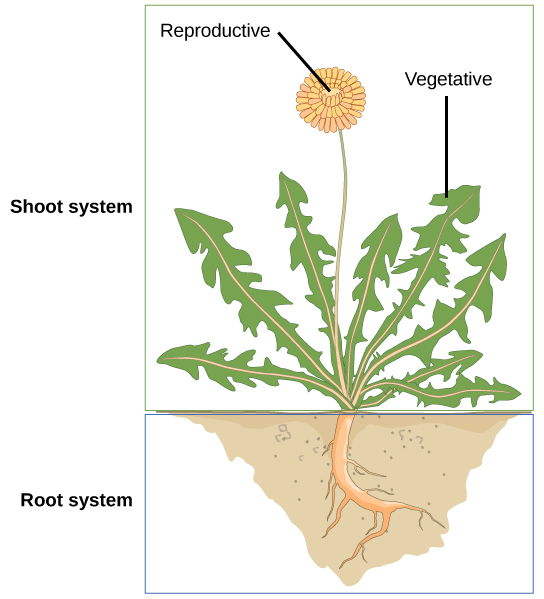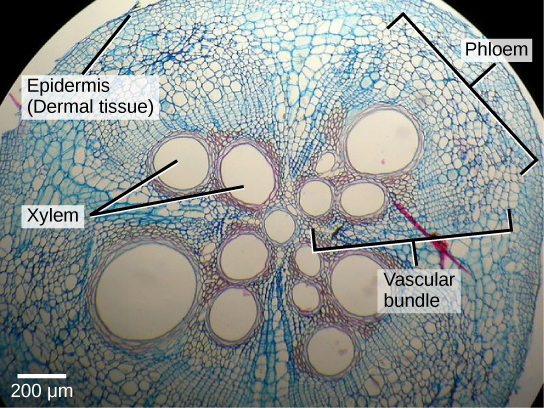30.1: 植物体
- Page ID
- 202387
培养技能
- 描述射击器官系统和根器官系统
- 区分分生组织和永久组织
- 确定并描述植物生长的三个区域
- 总结真皮组织、血管组织和地面组织的作用
- 将简单的植物组织与复杂的植物组织进行比较
像动物一样,植物含有带有细胞器的细胞,在这些细胞器中发生特定的代谢活动。 但是,与动物不同,植物在光合作用过程中利用来自阳光的能量来形成糖。 此外,植物细胞具有细胞壁、质体和较大的中央液泡:这些结构在动物细胞中找不到。 这些细胞结构中的每一种在植物结构和功能中都起着特定的作用。
植物器官系统
在植物中,就像在动物中一样,相似的细胞共同作用形成组织。 当不同类型的组织协同工作以发挥独特的功能时,它们就会形成器官;共同工作的器官形成器官系统。 维管植物有两个不同的器官系统:芽系和根系。 芽系由两部分组成:植物的生长(非繁殖)部分,例如叶子和茎,以及植物的繁殖部分,包括花朵和果实。 射击系统通常生长在地上,在那里它吸收光合作用所需的光。 支撑植物并吸收水分和矿物质的根系通常位于地下。 图\(\PageIndex{1}\) shows the organ systems of a typical plant.

Plant Tissues
Plants are multicellular eukaryotes with tissue systems made of various cell types that carry out specific functions. Plant tissue systems fall into one of two general types: meristematic tissue, and permanent (or non-meristematic) tissue. Cells of the meristematic tissue are found in meristems, which are plant regions of continuous cell division and growth. Meristematic tissue cells are either undifferentiated or incompletely differentiated, and they continue to divide and contribute to the growth of the plant. In contrast, permanent tissue consists of plant cells that are no longer actively dividing.
Meristematic tissues consist of three types, based on their location in the plant. Apical meristems contain meristematic tissue located at the tips of stems and roots, which enable a plant to extend in length. Lateral meristems facilitate growth in thickness or girth in a maturing plant. Intercalary meristems occur only in monocots, at the bases of leaf blades and at nodes (the areas where leaves attach to a stem). This tissue enables the monocot leaf blade to increase in length from the leaf base; for example, it allows lawn grass leaves to elongate even after repeated mowing.
Meristems produce cells that quickly differentiate, or specialize, and become permanent tissue. Such cells take on specific roles and lose their ability to divide further. They differentiate into three main types: dermal, vascular, and ground tissue. Dermal tissue covers and protects the plant, and vascular tissue transports water, minerals, and sugars to different parts of the plant. Ground tissue serves as a site for photosynthesis, provides a supporting matrix for the vascular tissue, and helps to store water and sugars.
Secondary tissues are either simple (composed of similar cell types) or complex (composed of different cell types). Dermal tissue, for example, is a simple tissue that covers the outer surface of the plant and controls gas exchange. Vascular tissue is an example of a complex tissue, and is made of two specialized conducting tissues: xylem and phloem. Xylem tissue transports water and nutrients from the roots to different parts of the plant, and includes three different cell types: vessel elements and tracheids (both of which conduct water), and xylem parenchyma. Phloem tissue, which transports organic compounds from the site of photosynthesis to other parts of the plant, consists of four different cell types: sieve cells (which conduct photosynthates), companion cells, phloem parenchyma, and phloem fibers. Unlike xylem conducting cells, phloem conducting cells are alive at maturity. The xylem and phloem always lie adjacent to each other (Figure \(\PageIndex{2}\)). In stems, the xylem and the phloem form a structure called a vascular bundle; in roots, this is termed the vascular stele or vascular cylinder.

Summary
A vascular plant consists of two organ systems: the shoot system and the root system. The shoot system includes the aboveground vegetative portions (stems and leaves) and reproductive parts (flowers and fruits). The root system supports the plant and is usually underground. A plant is composed of two main types of tissue: meristematic tissue and permanent tissue. Meristematic tissue consists of actively dividing cells found in root and shoot tips. As growth occurs, meristematic tissue differentiates into permanent tissue, which is categorized as either simple or complex. Simple tissues are made up of similar cell types; examples include dermal tissue and ground tissue. Dermal tissue provides the outer covering of the plant. Ground tissue is responsible for photosynthesis; it also supports vascular tissue and may store water and sugars. Complex tissues are made up of different cell types. Vascular tissue, for example, is made up of xylem and phloem cells.
Glossary
- apical meristem
- meristematic tissue located at the tips of stems and roots; enables a plant to extend in length
- dermal tissue
- protective plant tissue covering the outermost part of the plant; controls gas exchange
- ground tissue
- plant tissue involved in photosynthesis; provides support, and stores water and sugars
- intercalary meristem
- meristematic tissue located at nodes and the bases of leaf blades; found only in monocots
- lateral meristem
- meristematic tissue that enables a plant to increase in thickness or girth
- meristematic tissue
- tissue containing cells that constantly divide; contributes to plant growth
- meristem
- plant region of continuous growth
- permanent tissue
- plant tissue composed of cells that are no longer actively dividing
- root system
- belowground portion of the plant that supports the plant and absorbs water and minerals
- shoot system
- aboveground portion of the plant; consists of non-reproductive plant parts, such as leaves and stems, and reproductive parts, such as flowers and fruits
- vascular bundle
- strands of stem tissue made up of xylem and phloem
- vascular stele
- strands of root tissue made up of xylem and phloem
- vascular tissue
- tissue made up of xylem and phloem that transports food and water throughout the plant



